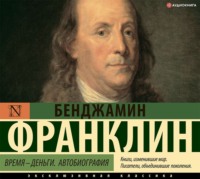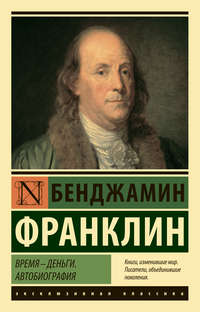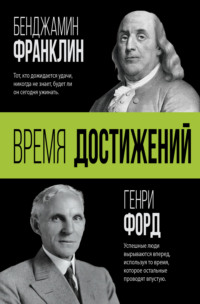![Memoirs of Benjamin Franklin; Written by Himself. [Vol. 2 of 2]](/covers_330/24858395.jpg) полная версия
полная версияMemoirs of Benjamin Franklin; Written by Himself. [Vol. 2 of 2]
Perhaps, when this globe was first formed, and its original particles took their place at certain distances from the centre, in proportion to their greater or less gravity, the fluid fire, attracted towards that centre, might in great part be obliged, as lightest, to take place above the rest, and thus form the sphere of fire above supposed, which would afterward be continually diminishing by the substance it afforded to organized bodies, and the quantity restored to it again by the burning or other separating of the parts of those bodies?
Is not the natural heat of animals thus produced, by separating in digestion the parts of food, and setting their fire at liberty?
Is it not this sphere of fire which kindles the wandering globes that sometimes pass through it in our course round the sun, have their surface kindled by it, and burst when their included air is greatly rarefied by the heat on their burning surfaces?
May it not have been from such considerations that the ancient philosophers supposed a sphere of fire to exist above the air of our atmosphere?
B. Franklin.Of Lightning; and the Methods now used in America for the securing Buildings and Persons from its mischievous Effects.
Experiments made in electricity first gave philosophers a suspicion that the matter of lightning was the same with the electric matter. Experiments afterward made on lightning obtained from the clouds by pointed rods, received into bottles, and subjected to every trial, have since proved this suspicion to be perfectly well founded; and that, whatever properties we find in electricity, are also the properties of lightning.
This matter of lightning or of electricity is an extreme subtile fluid, penetrating other bodies, and subsisting in them, equally diffused.
When, by any operation of art or nature, there happens to be a greater proportion of this fluid in one body than in another, the body which has most will communicate to that which has least, till the proportion becomes equal; provided the distance between them be not too great; or, if it is too great, till there be proper conductors to convey it from one to the other.
If the communication be through the air without any conductor, a bright light is seen between the bodies, and a sound is heard. In our small experiments we call this light and sound the electric spark and snap; but in the great operations of nature the light is what we call lightning, and the sound (produced at the same time, though generally arriving later at our ears than the light does to our eyes) is, with its echoes, called thunder.
If the communication of this fluid is by a conductor, it may be without either light or sound, the subtile fluid passing in the substance of the conductor.
If the conductor be good and of sufficient bigness, the fluid passes through it without hurting it. If otherwise, it is damaged or destroyed.
All metals and water are good conductors. Other bodies may become conductors by having some quantity of water in them, as wood and other materials used in building; but, not having much water in them, they are not good conductors, and, therefore, are often damaged in the operation.
Glass, wax, silk, wool, hair, feathers, and even wood, perfectly dry, are non-conductors: that is, they resist instead of facilitating the passage of this subtile fluid.
When this fluid has an opportunity of passing through two conductors, one good and sufficient, as of metal, the other not so good, it passes in the best, and will follow it in any direction.
The distance at which a body charged with this fluid will discharge itself suddenly, striking through the air into another body that is not charged or not so highly charged, is different according to the quantity of the fluid, the dimensions and form of the bodies themselves, and the state of the air between them. This distance, whatever it happens to be, between any two bodies, is called the striking distance, as, till they come within that distance of each other, no stroke will be made.
The clouds have often more of this fluid, in proportion, than the earth; in which case, as soon as they come near enough (that is, within the striking distance) or meet with a conductor, the fluid quits them and strikes into the earth. A cloud fully charged with this fluid, if so high as to be beyond the striking distance from the earth, passes quietly without making noise or giving light, unless it meets with other clouds that have less.
Tall trees and lofty buildings, as the towers and spires of churches, become sometimes conductors between the clouds and the earth; but, not being good ones, that is, not conveying the fluid freely, they are often damaged.
Buildings that have their roofs covered with lead or other metal, the spouts of metal continued from the roof into the ground to carry off the water, are never hurt by lightning as, whenever it falls on such a building, it passes in the metals and not in the walls.
When other buildings happen to be within the striking distance from such clouds, the fluid passes in the walls, whether of wood, brick, or stone, quitting the walls only when it can find better conductors near them, as metal rods, bolts, and hinges of windows or doors, gilding on wainscot or frames of pictures, the silvering on the backs of looking-glasses, the wires for bells, and the bodies of animals, as containing watery fluids. And, in passing through the house, it follows the direction of these conductors, taking as many in its way as can assist it in its passage, whether in a straight or crooked line, leaping from one to the other, if not far distant from each other, only rending the wall in the spaces where these partial good conductors are too distant from each other.
An iron rod being placed on the outside of a building, from the highest part continued down into the moist earth in any direction, straight or crooked, following the form of the roof or parts of the building, will receive the lightning at the upper end, attracting it so as to prevent its striking any other part, and affording it a good conveyance into the earth, will prevent its damaging any part of the building.
A small quantity of metal is found able to conduct a great quantity of this fluid. A wire no bigger than a goosequill has been known to conduct (with safety to the building as far as the wire was continued) a quantity of lightning that did prodigious damage both above and below it; and probably larger rods are not necessary, though it is common in America to make them of half an inch, some of three quarters or an inch diameter.
The rod may be fastened to the wall, chimney &c., with staples of iron. The lightning will not leave the rod (a good conductor) through those staples. It would rather, if any were in the walls, pass out of it into the rod, to get more readily by that conductor into the earth.
If the building be very large and extensive, two or more rods may be placed at different parts, for greater security.
Small ragged parts of clouds, suspended in the air between the great body of clouds and the earth (like leaf gold in electrical experiments) often serve as partial conductors for the lightning, which proceeds from one of them to another, and by their help comes within the striking distance to the earth or a building. It therefore strikes through those conductors a building that would otherwise be out of the striking distance.
Long sharp points communicating with the earth, and presented to such parts of clouds, drawing silently from them the fluid they are charged with, they are then attracted to the cloud, and may leave the distance so great as to be beyond the reach of striking.
It is therefore that we elevate the upper end of the rod six or eight feet above the highest part of the building, tapering it gradually to a fine sharp point, which is gilt to prevent its rusting.
Thus the pointed rod either prevents the stroke from the cloud, or, if a stroke is made, conducts it to the earth with safety to the building.
The lower end of the rod should enter the earth so deep as to come at the moist part, perhaps two or three feet; and if bent when under the surface so as to go in a horizontal line six or eight feet from the wall, and then bent again downward three or four feet, it will prevent damage to any of the stones of the foundation.
A person apprehensive of danger from lightning, happening during the time of thunder to be in a house not so secured, will do well to avoid sitting near the chimney, near a looking-glass, or any gilt pictures or wainscot; the safest place is the middle of the room (so it be not under a metal lustre suspended by a chain), sitting on one chair and laying the feet up in another. It is still safer to bring two or three mattresses or beds into the middle of the room, and, folding them up double, place the chair upon them; for they not being so good conductors as the walls, the lightning will not choose an interrupted course through the air of the room and the bedding, when it can go through a continued better conductor, the wall. But where it can be had, a hammock or swinging bed, suspended by silk cords equally distant from the walls on every side, and from the ceiling and floor above and below, affords the safest situation a person can have in any room whatever; and what, indeed, may be deemed quite free from danger of any stroke by lightning.
B. Franklin.Paris, September, 1767.
To Peter Collinson, LondonELECTRICAL KITEPhiladelphia, October 16, 1752.As frequent mention is made in public papers from Europe of the success of the Philadelphia experiment for drawing the electric fire from clouds by means of pointed rods of iron erected on high buildings, &c., it may be agreeable to the curious to be informed that the same experiment has succeeded in Philadelphia, though made in a different and more easy manner, which is as follows:
Make a small cross of two light strips of cedar, the arms so long as to reach to the four corners of a large thin silk handkerchief when extended; tie the corners of the handkerchief to the extremities of the cross, so you have the body of a kite, which, being properly accommodated with a tail, loop, and string, will rise in the air like those made of paper; but this, being of silk, is fitter to bear the wet and wind of a thunder-gust without tearing. To the top of the upright stick of the cross is to be fixed a very sharp-pointed wire, rising a foot or more above the wood. To the end of the twine next the hand is to be tied a silk riband, and where the silk and twine join, a key may be fastened. This kite is to be raised when a thunder-gust appears to be coming on, and the person who holds the string must stand within a door or window, or under some cover, so that the silk riband may not be wet; and care must be taken that the twine does not touch the frame of the door or window. As soon as any of the thunder-clouds come over the kite, the pointed wire will draw the electric fire from them, and the kite, with all the twine, will be electrified, and the loose filaments of the twine will stand out every way, and be attracted by an approaching finger. And when the rain has wetted the kite and twine, so that it can conduct the electric fire freely, you will find it stream out plentifully from the key on the approach of your knuckle. At this key the vial may be charged; and from electric fire thus obtained, spirits may be kindled, and all the other electric experiments be performed, which are usually done by the help of a rubbed glass globe or tube, and thereby the sameness of the electric matter with that of lightning completely demonstrated.
B. Franklin.Physical and Meteorological Observations, Conjectures, and Suppositions.– Read at the Royal Society, June 3, 1756.
The particles of air are kept at a distance from each other by their mutual repulsion * * *
Whatever particles of other matter (not endued with that repellancy) are supported in air, must adhere to the particles of air, and be supported by them; for in the vacancies there is nothing they can rest on.
Air and water mutually attract each other. Hence water will dissolve in air, as salt in water.
The specific gravity of matter is not altered by dividing the matter, though the superfices be increased. Sixteen leaden bullets, of an ounce each, weigh as much in water as one of a pound, whose superfices is less.
Therefore the supporting of salt in water is not owing to its superfices being increased.
A lump of salt, though laid at rest at the bottom of a vessel of water, will dissolve therein, and its parts move every way, till equally diffused in the water; therefore there is a mutual attraction between water and salt. Every particle of water assumes as many of salt as can adhere to it; when more is added, it precipitates, and will not remain suspended.
Water, in the same manner, will dissolve in air, every particle of air assuming one or more particles of water. When too much is added, it precipitates in rain.
But there not being the same contiguity between the particles of air as of water, the solution of water in air is not carried on without a motion of the air so as to cause a fresh accession of dry particles.
Part of a fluid, having more of what it dissolves, will communicate to other parts that have less. Thus very salt water, coming in contact with fresh, communicates its saltness till all is equal, and the sooner if there is a little motion of the water. * * *
Air, suffering continual changes in the degrees of its heat, from various causes and circumstances, and, consequently, changes in its specific gravity, must therefore be in continual motion.
A small quantity of fire mixed with water (or degree of heat therein) so weakens the cohesion of its particles, that those on the surface easily quit it and adhere to the particles of air.
Air moderately heated will support a greater quantity of water invisibly than cold air; for its particles being by heat repelled to a greater distance from each other, thereby more easily keep the particles of water that are annexed to them from running into cohesions that would obstruct, refract, or reflect the light.
Hence, when we breathe in warm air, though the same quantity of moisture may be taken up from the lungs as when we breathe in cold air, yet that moisture is not so visible.
Water being extremely heated, i. e., to the degree of boiling, its particles, in quitting it, so repel each other as to take up vastly more space than before and by that repellancy support themselves, expelling the air from the space they occupy. That degree of heat being lessened, they again mutually attract, and having no air particles mixed to adhere to, by which they might be supported and kept at a distance, they instantly fall, coalesce, and become water again.
The water commonly diffused in our atmosphere never receives such a degree of heat from the sun or other cause as water has when boiling; it is not, therefore, supported by such heat, but by adhering to air. * * *
A particle of air loaded with adhering water or any other matter, is heavier than before, and would descend.
The atmosphere supposed at rest, a loaded descending particle must act with a force on the particles it passes between or meets with sufficient to overcome, in some degree, their mutual repellancy, and push them nearer to each other. * * *
Every particle of air, therefore, will bear any load inferior to the force of these repulsions.
Hence the support of fogs, mists, clouds.
Very warm air, clear, though supporting a very great quantity of moisture, will grow turbid and cloudy on the mixture of colder air, as foggy, turbid air will grow clear by warming.
Thus the sun, shining on a morning fog, dissipates it; clouds are seen to waste in a sunshiny day.
But cold condenses and renders visible the vapour: a tankard or decanter filled with cold water will condense the moisture of warm, clear air on its outside, where it becomes visible as dew, coalesces into drops, descends in little streams.
The sun heats the air of our atmosphere most near the surface of the earth; for there, besides the direct rays, there are many reflections. Moreover, the earth itself, being heated, communicates of its heat to the neighbouring air.
The higher regions, having only the direct rays of the sun passing through them, are comparatively very cold. Hence the cold air on the tops of mountains, and snow on some of them all the year, even in the torrid zone. Hence hail in summer.
If the atmosphere were, all of it (both above and below), always of the same temper as to cold or heat, then the upper air would always be rarer than the lower, because the pressure on it is less; consequently lighter, and, therefore, would keep its place.
But the upper air may be more condensed by cold than the lower air by pressure; the lower more expanded by heat than the upper for want of pressure. In such case the upper air will become the heavier, the lower the lighter.
The lower region of air being heated and expanded, heaves up and supports for some time the colder, heavier air above, and will continue to support it while the equilibrium is kept. Thus water is supported in an inverted open glass, while the equilibrium is maintained by the equal pressure upward of the air below; but the equilibrium by any means breaking, the water descends on the heavier side, and the air rises into its place.
The lifted heavy cold air over a heated country becoming by any means unequally supported or unequal in its weight, the heaviest part descends first, and the rest follows impetuously. Hence gusts after heats, and hurricanes in hot climates. Hence the air of gusts and hurricanes is cold, though in hot climates and seasons; it coming from above.
The cold air descending from above, as it penetrates our warm region full of watery particles, condenses them, renders them visible, forms a cloud thick and dark, overcasting sometimes, at once, large and extensive; sometimes, when seen at a distance, small at first, gradually increasing; the cold edge or surface of the cloud condensing the vapours next it, which form smaller clouds that join it, increase its bulk, it descends with the wind and its acquired weight, draws nearer the earth, grows denser with continual additions of water, and discharges heavy showers.
Small black clouds thus appearing in a clear sky, in hot climates portend storms, and warn seamen to hand their sails.
The earth turning on its axis in about twenty-four hours, the equatorial parts must move about fifteen miles in each minute; in northern and southern latitudes this motion is gradually less to the poles, and there nothing.
If there was a general calm over the face of the globe, it must be by the air's moving in every part as fast as the earth or sea it covers. * * *
The air under the equator and between the tropics being constantly heated and rarefied by the sun, rises. Its place is supplied by air from northern and southern latitudes, which, coming from parts wherein the earth and air had less motion, and not suddenly acquiring the quicker motion of the equatorial earth, appears an east wind blowing westward; the earth moving from west to east, and slipping under the air.37
Thus, when we ride in a calm, it seems a wind against us: if we ride with the wind, and faster, even that will seem a small wind against us.
The air rarefied between the tropics, and rising, must flow in the higher region north and south. Before it rose it had acquired the greatest motion the earth's rotation could give it. It retains some degree of this motion, and descending in higher latitudes, where the earth's motion is less, will appear a westerly wind, yet tending towards the equatorial parts, to supply the vacancy occasioned by the air of the lower regions flowing thitherward.
Hence our general cold winds are about northwest, our summer cold gusts the same.
The air in sultry weather, though not cloudy, has a kind of haziness in it, which makes objects at a distance appear dull and indistinct. This haziness is occasioned by the great quantity of moisture equally diffused in that air. When, by the cold wind blowing down among it, it is condensed into clouds, and falls in rain, the air becomes purer and clearer. Hence, after gusts, distant objects appear distinct, their figures sharply terminated.
Extreme cold winds congeal the surface of the earth by carrying off its fire. Warm winds afterward blowing over that frozen surface will be chilled by it. Could that frozen surface be turned under, and warmer turned up from beneath it, those warm winds would not be chilled so much.
The surface of the earth is also sometimes much heated by the sun: and such heated surface, not being changed, heats the air that moves over it.
Seas, lakes, and great bodies of water, agitated by the winds, continually change surfaces; the cold surface in winter is turned under by the rolling of the waves, and a warmer turned up; in summer the warm is turned under, and colder turned up. Hence the more equal temper of seawater, and the air over it. Hence, in winter, winds from the sea seem warm, winds from the land cold. In summer the contrary.
Therefore the lakes northwest of us,38 as they are not so much frozen, nor so apt to freeze as the earth, rather moderate than increase the coldness of our winter winds.
The air over the sea being warmer, and, therefore, lighter in winter than the air over the frozen land, may be another cause of our general northwest winds, which blow off to sea at right angles from our North American coast. The warm, light sea-air rising, the heavy, cold land-air pressing into its place.
Heavy fluids, descending, frequently form eddies or whirlpools, as is seen in a funnel, where the water acquires a circular motion, receding every way from a centre, and leaving a vacancy in the middle, greatest above, and lessening downward, like a speaking-trumpet, its big end upward.
Air, descending or ascending, may form the same kind of eddies or whirlings, the parts of air acquiring a circular motion, and receding from the middle of the circle by a centrifugal force, and leaving there a vacancy; if descending, greatest above and lessening downward; if ascending, greatest below and lessening upward; like a speaking-trumpet standing its big end on the ground.
When the air descends with a violence in some places, it may rise with equal violence in others, and form both kinds of whirlwinds.
The air, in its whirling motion, receding every way from the centre or axis of the trumpet, leaves there a vacuum, which cannot be filled through the sides, the whirling air, as an arch, preventing; it must then press in at the open ends.
The greatest pressure inward must be at the lower end, the greatest weight of the surrounding atmosphere being there. The air, entering, rises within, and carries up dust, leaves, and even heavier bodies that happen in its way, as the eddy or whirl passes over land.
If it passes over water, the weight of the surrounding atmosphere forces up the water into the vacuity, part of which, by degrees, joins with the whirling air, and, adding weight and receiving accelerated motion, recedes farther from the centre or axis of the trump as the pressure lessens; and at last, as the trump widens, is broken into small particles, and so united with air as to be supported by it, and become black clouds at the top of the trump.
Thus these eddies may be whirlwinds at land, water-spouts at sea. A body of water so raised may be suddenly let fall, when the motion, &c., has not strength to support it, or the whirling arch is broken so as to admit the air: falling in the sea, it is harmless unless ships happen under it; and if in the progressive motion of the whirl it has moved from the sea over the land, and then breaks, sudden, violent, and mischievous torrents are the consequences.
To Dr. Perkins Water-spouts and Whirlwinds compared.– Read at the Royal Society, June 24, 1753Philadelphia, Feb. 4, 1753.I ought to have written to you long since, in answer to yours of October 16, concerning the water-spout; but business partly, and partly a desire of procuring farther information by inquiry among my seafaring acquaintance, induced me to postpone writing, from time to time, till I am almost ashamed to resume the subject, not knowing but you may have forgot what has been said upon it.









